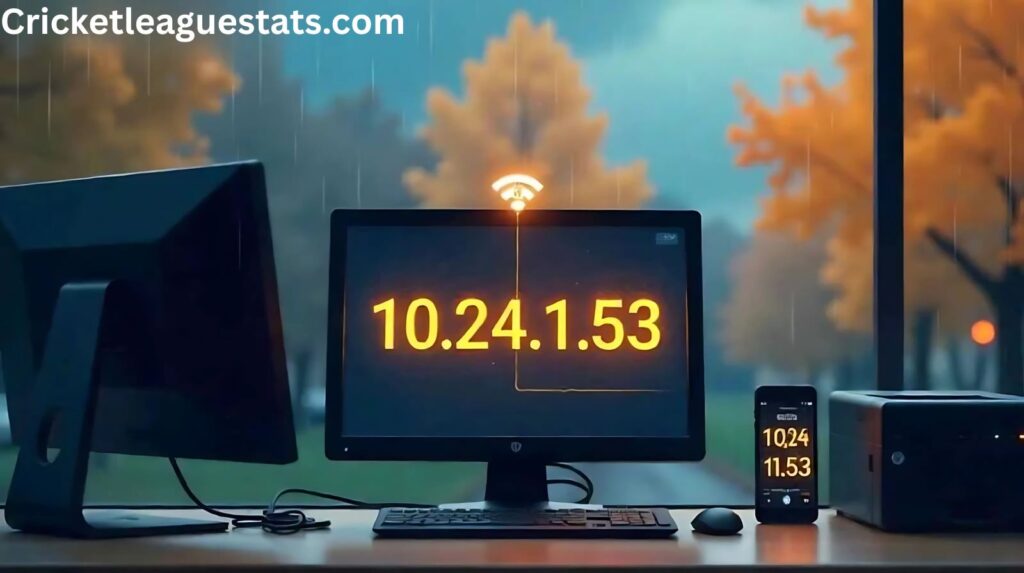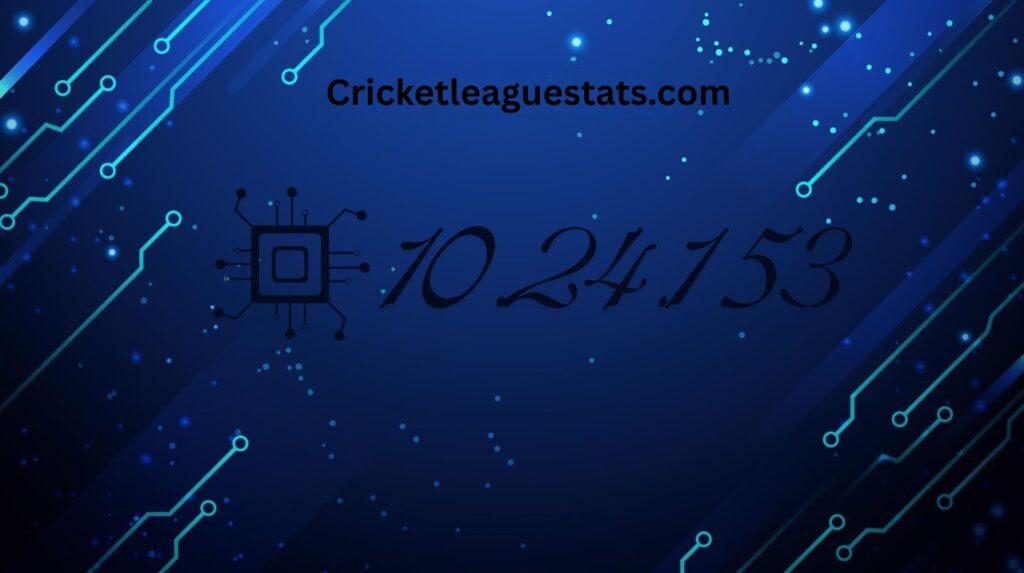10.24.1.53: In the sprawling metropolis of the internet, public websites and services like to grab all the headlines when we talk about protocols and technologies, but there is a second world hidden from sight that is equally critical to service providers large and small around the globe: private networks. This is the land of RFC 1918, home to non-routable IP addresses. And of all those little unsung heroes, an address softly hums with a purpose: 10.24.1.53. This is not an address you will ever type into your public web browser to go shopping or socializing. But in thousands of corporate offices, university buildings and industrial facilities around the U.S., this particular string of numbers serves a critical role in a little-known trade ecosystem.
This article is an adventure into the heart of this private network address. We will investigate what it is, why it exists in the way that we see it now, which kinds of devices can be part of it and how determinant its action is toward today’s uninterrupted functioning organizations. Never mind those glamorous public IPs; let’s head behind the scenes to hang out with the digital workhorse that goes where no one sees but who keeps all the internal machinery running.
Understanding the “10.x.x.x” Universe: The RFC 1918 Standard
In order to know 10.24.1.53, let’s trace its’ family tree for clarity of origin! It is part of the private network 10.0.0.0/8 range, which is reserved for use in private networks according to Internet Engineering Task Force (IETF) RFC 1918, published by the Internet Engineering Task Force (IETF).
What is RFC 1918?
In the early years of the internet, it became clear that there wouldn’t be enough available IPv4 addresses (just 4.3 billion) to assign addresses for every device in the world. RFC 1918 was the answer: it set aside three ranges of addresses for private use only, internal to an organization. These IPs are not globally unique and cannot be routed on the internet. It enables the entire plane to reuse those same addresses internally without colliding with one another.
The three reserved blocks are:
10.0.0.0/8 is an enormously vast address space of 16,777,216 addresses that ranges from 10.0.0.0 to 10.255.255.255 and in practice just means “a bunch of private IP addresses.”
172.16.0.0/12 (172.16/12): A smaller block partitioned from 172.16.0.0 to 172.31.255.255.
192.168.0.0/16: Traditionally the most common in home networks from 192.168.0 to 192.168.255 but divided into /24 sections, like so:.2/.3/.4 and so on found on your home router (most of the time).
The “10. block is the bigge — x.xh”est and isometricaStepThroughx.h.xh”is “mallesttypically favored by medium to large enterprises for its sheer scale and flexibility in structuring internal networks.
The Anatomy of a Subnet: Why “10.24.1.x”?
The IP 10.24.1.53 is not just any ip address assigned at random. Its layout is evidence of an organized network design practice called subnetting.
An IP address is comprised of two parts, the Network Prefix and the Host Identifier. In other words, in the example of 10.24.1.53 we know they must share a subnet mask, such as 255.255.255.0 (or /24 formatted CIDR).
This is the Network Prefix. It is a subnet of the larger 10.0.0.0/8 corporate network.
The major corporate network.
May represent a particular geography (such as the 24th floor, Building 24 or branch office code).
Probably to a location that isn’t quite as specific and then the sender probably references a particular department or VLAN in that location (maybe like, The Finance Department VLAN).
This is the Host Identifier. It means just one device in 10.24.1.0/24. This subnet is big enough to contain addresses from 10.24.1.1 to 10.24.1.254 (with. 0 and. 255 typically reserved).
This layered architecture is important for the ability to provide certain security features, performance features and manageability. It gives network administrators the ability to separate traffic, apply particular security policies to “10.24.1. x” network, and easily find a device(headers) Find a device fast. security policies to the “10.24.1.x” network, and quickly locate a device.
The Many Faces of 10.24.1.53: A Device Profile

Well, then what is sitting at 10.24.1.53? The host ID indicates that it was probably not a dynamic allocation (that is, from a DHCP server and instead probably configured statically) as the latter type of IP would typically start higher up like IP ending in.147 (especially in my country). 100). This is an indication of a device which requires a permanent, consistent address. Delve into the most likely contenders.
The Network-Attached Storage (NAS) Unit
In a business scenario, this would be something like a NAS box operating as a dedicated file server for one of your departments. It would be statically ip’d so that employees in the “10.24.1. x” network that my computer is connected to and from which they can always map their drives to without having the address change. It’s where the finance or HR department knows to find their digital filing cabinet, always in the same place.
The Critical Application Server
Maybe 10.24.1.53 is running some business app that only employees are supposed to use – your intranet, a CRM database of customers, or even things like Jira or an internal wiki where the team logs tickets and notes time on various projects. Because it lives on a private IP, the system isn’t even exposed to outside attacks (aside from employees who are on the company network or using a secure VPN).
The Print Server or All In One Printer
The high-end networked printer/copier/scanner on the 24th floor is a stereotypical resident of an IP address like this. When you click “Print,” the document is sent to 10.24.1.53, which takes care of queuing and such. Static IP and printer driver will not change no matter how many PCs you use.
Read More: Australian Men’s Cricket Team vs India National Cricket Team Timeline
The Industrial Control System (ICS) or Building Management Controller
In a factory or smart building, 10.24.1.53 might otherwise be the controller for an HVAC system, as conveyor belt or as assembly line robot. This makes it part of the Operational Technology (OT) world and in this case, network reliability and consistent addressing are most important to safety as well as performance.
A Virtual Machine or Container
I highly doubt why 10.24.1.53 is just not a Virtual thing in a virtualized modern Data Center? It might be a virtual machine being booted by Linux or Windows to provide a particular service, or perhaps an application run inside a Docker container. Its “physical” location is on a hypervisor host, one of many in a server rack.
Potential Device Profiles for 10.24.1.53
| Device Type | Role & Function | Rationale for Static IP |
|---|---|---|
| Network-Attached Storage (NAS) | Departmental file server for shared documents and resources. | Requires a permanent address for reliable network drive mapping. |
| Application Server | Hosts internal software (CRM, Intranet, Database). | Users and systems need a consistent endpoint to connect to. |
| Network Printer/Scanner | Centralized printing for a department or floor. | Printers must be reliably discovered by all users on the network. |
| Industrial Controller (PLC/SCADA) | Manages machinery, HVAC, or physical infrastructure. | Critical systems demand unchanging network identities. |
| Virtual Machine / Container | Runs a specific software service in a virtualized environment. | Often assigned a static IP for inter-service communication. |
| IP Phone | A Voice-over-IP (VoIP) telephone on a specific desk. | For consistent registration with the IP-PBX phone system. |
| Access Control System | Manages electronic door locks for a secure area. | Security systems require reliable and fixed network paths. |
The Administrator’s Perspective: Managing and Securing 10.24.1.53
For a network or systems admin, 10.24.1.53 is not merely an address – it’s a resource to manage, monitor and protect.
Documentation: Such IP would be carefully documented in an IP Address Management (IPAM) solution or a spreadsheet together with its hostname, MAC address, device type and responsible owner.
Policies: Here the FW Rules for subnet “10.24.1.0/24” would be developed. 10.24.1.53 could only be accessible from some other subnets, as well. For instance, the IT management subnet (e.g., 10.100.1. x) would not be permitted to SSH into it, but the opposite of what you want. x) may only be permitted to access to its own type service port (e.g., port 80 for web UI, port 445 for file sharing).
Monitoring and Maintenance: Your admin’s server monitoring system (like Nagios, PRTG or Zabbix) would be watching to make sure 10.24.1.53 is “alive” (meaning it can respond to pings) and all of its services are running as they should be. They would also have to apply OS patches and software updates to this device, usually on some specified maintenance window.
Read More: Sunrisers Hyderabad vs Delhi Capitals Timeline
Conclusion: The Unsung Hero of the Digital Age
10.24.1.53 is a tiny example of the contemporary, sophisticated and largely hidden infrastructure that drives our world. It is due to pre existing network design standards such as the RFC 1918 and hard work of IT pros. It’s an emblem of order in the digital wild west, safety by hiding and the hard-and-fast fact that not every important thing needs a face on a website.
Pick from the next time you effortlessly save a file to a network drive, print get through it and checking data on an internal dashboard – chances are very good that you’re interfacing with something closely related to 10.24.1.53. It may not have the appeal of a google com or a facebook. com, but in its private cosmos it is just as significant. It’s an unsung, solid and necessary member of the private network community
FAQs About 10.24.1.53
Q1: I discover 10.24.1.53 in my home network? Is that normal?
A: It is theoretically possible, but very unlikely in a typical home network configuration. Nearly all home routers use 192.168. x.x (for example 192.168.1.1 for the router). If you are seeing a 10.24.1.53 on your home network and nothing is known to use that address, it is possible your DHCP capable router has been set up with manual settings similar to a device connected to the Internet and could in fact be using the IP Address the router refers to as 10. x.x.x/xx is either a route in the x.x.0.0/16 range that you have manually created, or there is something on your corporate device VPNed into the network that it advertising this route.
Q. Can I connect to 10.24.1.53 from the outside?
A: No, you cannot. Addresses from 10.0.0.0 to 10.255.255.255 are not routable outside of your networked subnets of the Class A range (8). All pings or any other connection to 10.24.1.53 from beyond its own private network will be dropped. You would have to first set up a secure connection (eg a VPN) into that private network, after which your computer would behave as if it were locally connected.
Q3: Why is the host ID “. 53”? Is there some special significance?
A: The host ID. 53 does not have a built-in technical meaning. It was almost definitely picked by a network admin or some sort of configuration script. It may be serial or a code (3rd device in the 5th sector), but its primary function is to be unique within that sub-network.
Q4: Describe how a static and dynamic IP work, and which one is 10.24.1.53?
A: A dynamic IP address is one that is temporarily assigned to you by a DHCP server and can change. Static IP is permanently set on the actual device. Given the low host ID (. 53) you can be pretty sure to take a bet that 10.24.1.53 is a static IP, assigned to a device with fixed (static) network interface.
Q5: Can I hack it if I know this IP?
A: Knowing the internal IP is first of all a tiny little step and pretty much useless unless you are sitting inside the same private network. Even today, current generation networks are locked down with firewalls, authentication and access control lists. Attempts at unauthorized access are not only unlawful, but also unethical. This post is meant as an educational article to understand network infrastructure, not for misuse.


